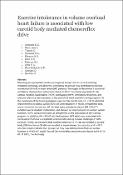Options
Exercise intolerance in volume overload heart failure is associated with low carotid body mediated chemoreflex drive
Fecha de emisión
2021-12
Autor(es)
Andrade, David Cristóbal
Díaz-Jara, Esteban
Toledo, Camilo
Schwarz, Karla G.
Pereyra, Katherin V.
Díaz, Hugo S.
Marcus, Noah J.
Ortiz, Fernando C.
Ríos-Gallardo, Angélica P.
Ortolani, Domiziana
del Río, Rodrigo R.
DOI
10.1038/s41598-021-93791-8
Resumen
Mounting an appropriate ventilatory response to exercise is crucial to meeting metabolic demands, and abnormal ventilatory responses may contribute to exercise-intolerance (EX-inT) in heart failure (HF) patients. We sought to determine if abnormal ventilatory chemoreflex control contributes to EX-inT in volume-overload HF rats. Cardiac function, hypercapnic (HCVR) and hypoxic (HVR) ventilatory responses, and exercise tolerance were assessed at the end of a 6 week exercise training program. At the conclusion of the training program, exercise tolerant HF rats (HF + EX-T) exhibited improvements in cardiac systolic function and reductions in HCVR, sympathetic tone, and arrhythmias. In contrast, HF rats that were exercise intolerant (HF + EX-inT) exhibited worse diastolic dysfunction, and showed no improvements in cardiac systolic function, HCVR, sympathetic tone, or arrhythmias at the conclusion of the training program. In addition, HF + EX-inT rats had impaired HVR which was associated with increased arrhythmia susceptibility and mortality during hypoxic challenges (~ 60% survival). Finally, we observed that exercise tolerance in HF rats was related to carotid body (CB) function as CB ablation resulted in impaired exercise capacity in HF + EX-T rats. Our results indicate that: (i) exercise may have detrimental effects on cardiac function in HF-EX-inT, and (ii) loss of CB chemoreflex sensitivity contributes to EX-inT in HF.
Archivo(s)
Loading...
Name
Exerciseintoleranceinvolumeoverloadheartfailureisassociatedwithlowcarotidbodymediatedchemoreflexdrive.pdf
Size
60.68 KB
Format
Checksum